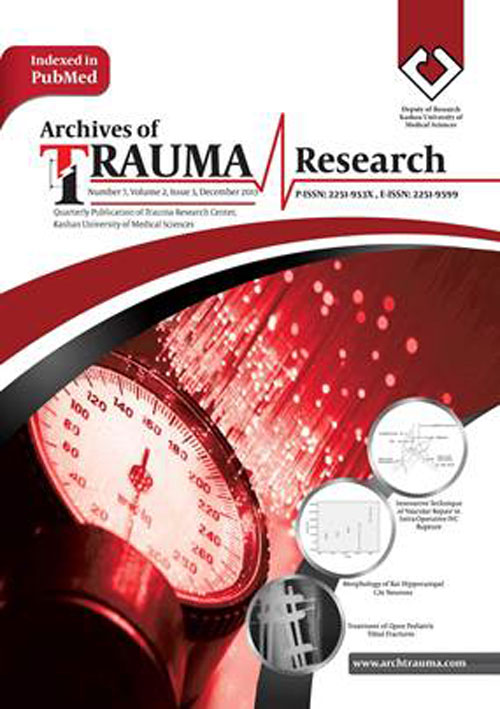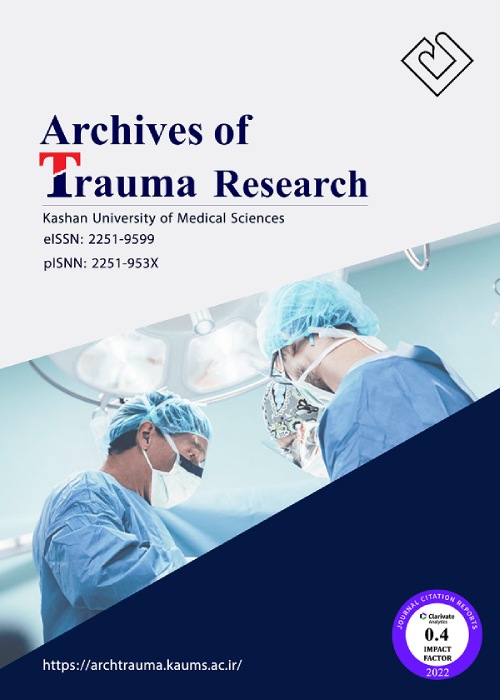فهرست مطالب

Archives of Trauma Research
Volume:5 Issue: 1, Jan-Mar 2016
- تاریخ انتشار: 1394/12/02
- تعداد عناوین: 9
-
-
Page 1BackgroundDeep venous thrombosis (DVT) and pulmonary embolism (PE) are recognized as major causes of morbidity and mortality in orthopaedic trauma patients. Despite the high incidence of these complications following orthopaedic trauma, there is a paucity of literature investigating the clinical risk factors for DVT in this specific population. As our healthcare system increasingly emphasizes quality measures, it is critical for orthopaedic surgeons to understand the clinical factors that increase the risk of DVT following orthopaedic trauma..ObjectivesUtilizing the ACS-NSQIP database, we sought to determine the incidence and identify independent risk factors for DVT following orthopaedic trauma..Patients andMethodsUsing current procedural terminology (CPT) codes for orthopaedic trauma procedures, we identified a prospective cohort of patients from the 2006 to 2013 ACS-NSQIP database. Using Wilcoxon-Mann-Whitney and chi-square tests where appropriate, patient demographics, comorbidities, and operative factors were compared between patients who developed a DVT within 30 days of surgery and those who did not. A multivariate logistic regression analysis was conducted to calculate odds ratios (ORs) and identify independent risk factors for DVT. Significance was set at P < 0.05..Results56,299 orthopaedic trauma patients were included in the analysis, of which 473 (0.84%) developed a DVT within 30 days. In univariate analysis, twenty-five variables were significantly associated with the development of a DVT, including age (P < 0.0001), BMI (P = 0.037), diabetes (P = 0.01), ASA score (P < 0.0001) and anatomic region injured (P < 0.0001). Multivariate analysis identified several independent risk factors for development of a DVT including use of a ventilator (OR = 43.67, P = 0.039), ascites (OR = 41.61, P = 0.0038), steroid use (OR = 4.00, P < 0.001), and alcohol use (OR = 2.98, P = 0.0370). Compared to patients with upper extremity trauma, those with lower extremity injuries had significantly increased odds of developing a DVT (OR = 7.55, P = 0.006). The trend toward increased odds of DVT among patients with injuries to the hip/pelvis did not reach statistical significance (OR = 4.51, P = 0.22). Smoking was not found to be an independent risk factor for developing a DVT (P = 0.1217)..ConclusionsThis is the largest study to date using the NSQIP database to identify risk factors for DVT in orthopaedic trauma patients. Although the incidence of DVT was low in our cohort, the presence of certain risk factors significantly increased the odds of developing a DVT following orthopaedic trauma. These findings will enable orthopaedic surgeons to target at-risk patients and implement post-operative care protocols aimed at reducing the morbidity and mortality associated with DVT in orthopaedic trauma patients..Keywords: Pulmonary Embolism, Venous Thromboembolism, Orthopaedic Trauma, Thromboprophylaxis, Deep Venous Thrombosis
-
Page 2BackgroundAccording to general ethical and legal principles, valid consent must be obtained before starting any procedure..ObjectivesDue to the lack of a standard tool for assessing patients’ capacity to consent to medical treatment in Iran, the present study was carried out aiming to devise a Persian version of a cross-cultural adaptation of the MacArthur competence assessment tool..Patients andMethodsBy reviewing different methods of cultural translation and adaptation for assessment tools, and due to the lack of consensus on its processes, we selected Wild’s model as one of the most comprehensive methods in this regard. Wild’s (2005) 10-stage model includes preparation, forward translation, reconciliation of the forward translation, back translation of reconciliation, back translation review, cognitive debriefing and cognitive review, and finalization, proofreading and final reporting. Using this model, we translated the MacArthur assessment tool and made it adaptable to Iranian patients..ResultsThe MacArthur assessment tool is not dependent on any specific culture and language. As a result, if translation and its scientific adaptation are done based on an integrated and detailed model, the tool can be used for every culture and language. In other words, this tool is not culture-specific; so, it is applicable in cases where a translation is needed, and it can be culturally adapted to suit different societies..ConclusionsIn the present study, we are able to focus on and prove the efficacy and benefits of this measurement tool..Keywords: Decision, Making Capacity, Competency, Assessment Tools for Treatment, Translation, Cross, Cultural Adaptation, Macarthur Assessment Tool
-
Page 3BackgroundTraumatic dental injuries to anterior teeth are a significant public health problem, not only because their prevalence is relatively high, but also because they have considerable impact on children’s daily lives. Traumatic dental injuries (TDIs) cause physical and psychological discomfort, pain and other negative impacts, such as tendency to avoid laughing or smiling, which can affect social relationships..ObjectivesThis study aimed to assess the prevalence of traumatic dental injuries to anterior teeth among 12-year-old school children in Kashmir, India..Patients andMethodsA cross-sectional study was conducted in private and government schools of India, among 1600 schoolchildren, aged 12 years. In addition to recording of the type of trauma (using Ellis and Davey classification of fractures, 1970), over jet, Angle’s molar relation and lip competence was also recorded. The socioeconomic status and academic performance of the study subjects was registered. The data obtained were compiled systematically and then statistically analyzed. The statistical significance for the association between the traumatic injury and the variables was analyzed using the chi-square test. Logistic regression was used to identify potential risk predictors of TDIs..ResultsThe overall prevalence of TDI to anterior teeth was found to be 9.3%. The TDI to anterior teeth in male was more than female, but the difference was statistically non-significant (p < 0.01). Falls and sports were the most common causes of trauma in the present study. The highest potential risk factor for the occurrence of trauma was over jet. Academic performance was found to be significantly associated to TDI to anterior teeth, when analyzed in a multiple regression model..ConclusionsIt was concluded that the prevalence of traumatic dental injuries was 9.3%. Traumatic dental injuries among children exhibit complex interaction between the victims’ oral conditions and their behavior. Therefore, prevention should consider a number of characteristics such as oral predisposing factors, environmental determinants and human behavior. It is recommended that specific and proper public places for leisure and sports activities, with impact-absorbing surfaces around the items on which children are most likely to fall, should be provided..Keywords: Traumatic Dental Injuries, Schools, Risks
-
Page 4BackgroundBlunt chest trauma (BCT) poses significant morbidity and mortality worldwide..ObjectivesWe investigated the clinical presentation and outcome of BCT related to road traffic accidents (RTA)..Patients andMethodsA retrospective observational analysis for patients who sustained BCT secondary to RTA in terms of motor vehicle crash (MVC) and pedestrian-motor vehicle accidents (PMVA) who were admitted to the trauma center at Hamad general hospital, Doha, Qatar, between 2008 and 2011..ResultsOf 5118 traumatic injury cases, 1004 (20%) were found to have BCT secondary to RTA (77% MVC and 23% PMVA). The majority were males (92%), and expatriates (72%). Among MVCs, 84% reported they did not use protective devices. There was a correlation between chest abbreviated injury score (AIS) and injury severity scoring (ISS) (r = 0.35, r2 = 0.12, P < 0.001). Regardless of mechanism of injury (MOI), multivariate analysis showed that the head injury associated with chest AIS and ISS was a predictor of mortality in BCT. Overall mortality was 15%, and the highest rate was observed within the first 24 hours post-trauma..ConclusionsBlunt chest trauma from RTA represents one-fifth of the total trauma admissions in Qatar, with a high overall mortality. Pedestrians are likely to have more severe injuries and higher fatality rates than MVC victims. Specific injury prevention programs focusing on road safety should be implemented to minimize the incidence of such preventable injuries..Keywords: Chest Trauma, Road Traffic Accidents, Injury, Pedestrians, Motor Vehicle Crashes
-
Page 5BackgroundIn the restoration of elbow flexion, the phrenic nerve has proven to be a good donor, but considering the role of the phrenic nerve in respiratory function, we cannot disregard the potential dangers of this method..ObjectivesIn the current study, we reviewed the results of pulmonary function tests (PFT) in four patients who underwent phrenic nerve transfer..Patients andMethodsWe reviewed the results of serial spirometry tests, which were performed before and after phrenic nerve transfer surgery..ResultsAll patients regained Biceps power to M3 strength or above. None of our patients experienced pulmonary problems or respiratory complaints, but a significant reduction of spirometric parameters occurred after surgery..ConclusionsThis study highlights the close link between the role of the phrenic nerve and pulmonary function, such that the use of this nerve as a transfer donor leads to spirometric impairments..Keywords: Phrenic Nerve Transfer, Pulmonary Function Tests, Elbow
-
Page 6IntroductionSimultaneous contraction of the extensor carpi radialis longus (ECRL) with forced hyperflexion of the wrist can result in avulsion of the tendon and its bony attachment at its insertion at the dorsum of the base of the second metacarpal. This is a rare and often unreported fracture pattern..Case PresentationWe present a 31- year- old male who sustained a hyperflexion injury. He was managed surgically and had good post-operative outcomes. A literature search revealed 16 papers covering 18 cases of similar injuries. 12 were initially managed surgically and 6 were managed conservatively..ConclusionsOf the open reductions and internal fixations, 11 (92%) were successful and patients made a full recovery. Conservative management was unsuccessful in 4 cases; one patient required surgery for metacarpal boss, one patient had retraction of the tendon at one week follow up and another had weak flexion of the wrist. We recommend open reduction and internal fixation for these injuries. It may allow a faster recovery and therefore allow an earlier return to work and activity..Keywords: Ecrl, Extensor Carpi Radialis Longus, Avulsion, Metacarpal, Tendon
-
Page 7IntroductionThe distal triceps tendon rupture is an uncommon injury. The acute treatment is well-defined, but when a delayed diagnosis is made or when a tendon retraction is present the alternatives or reconstruction are limited and sometimes complex..Case PresentationIn this case, we report on a 28-year-old man who presented with a chronic disruption of the distal triceps tendon with a gap of approximately 15 cm. The patient was diagnosed in another center with an inveterate breakage of the distal triceps tendon and was initially treated with an Achilles allograft that was complicated by a wound infection and required more than ten surgeries. Nearly 22 months after the initial trauma, and 12 months after the first surgery, we performed a reconstruction with an Achilles tendon allograft using the new technique of distal attachment. At the 12-month follow-up the patient presented a joint balance from -5º to 110º and presented with no pain..ConclusionsThe use of an Achilles tendon allograft provides excellent results in complex distal triceps tendon ruptures. We report the use of a new technique to anchor a distal Achilles allograft..Keywords: Tendon, Tendon Injuries, Achilles Tendon
-
Page 8IntroductionPenetrating thoracoabdominal injuries are potentially life threatening due to the associated hemorrhagic shock and visceral injury. Through and through penetrating injury with polytrauma is rarely encountered..Case PresentationHere we report on a 25-year-old male with penetrating thoracoabdominal injury caused by a metallic (iron) bar projecting from a pillar of a construction site after he fell down from a height..ConclusionsAnesthetic and surgical management was difficult due to the inability to position in supine and rapidly progressing hemorrhagic shock. Surgical management for extraction of this iron bar and intensive monitoring and resuscitation resulted in an uneventful successful outcome..Keywords: Thoracoabdominal, Metallic, Penetrating Traum
-
Page 9IntroductionThe nasolabial flap (NLF) has many advantages in oromaxillary reconstruction, but the majority of cases are reconstructions after pathologic resections. Its usage in trauma surgery, especially in the management of gunshot wounds, is rarely mentioned..Case PresentationThree cases involving gunshot injuries to the face are presented: one for reconstruction of the nasal ala, another for bone graft coverage in mandibular reconstruction, and the third for the repair of premaxillary hard and soft tissue avulsive defects..ConclusionsThe NLF is a thin, pliable flap and is useful for intraoral and facial reconstruction of trauma patients with small to moderate soft tissue loss..Keywords: Flap, Trauma, Reconstruction


